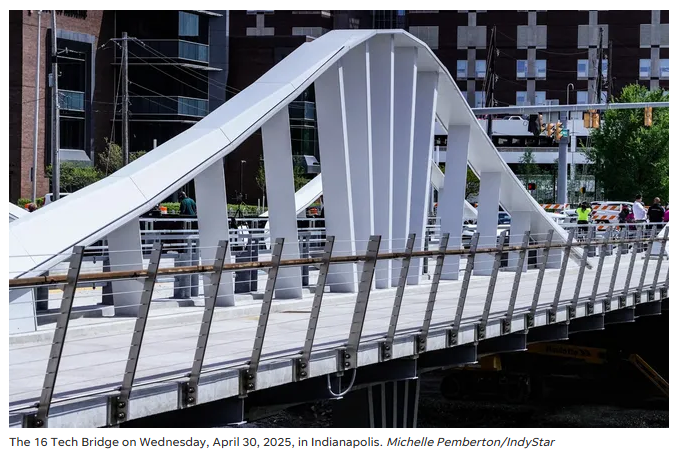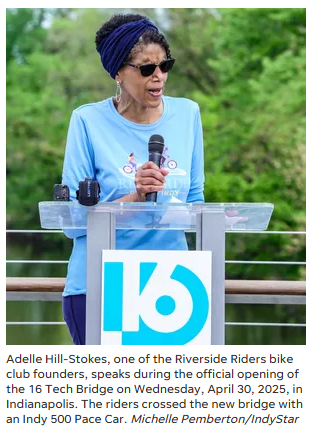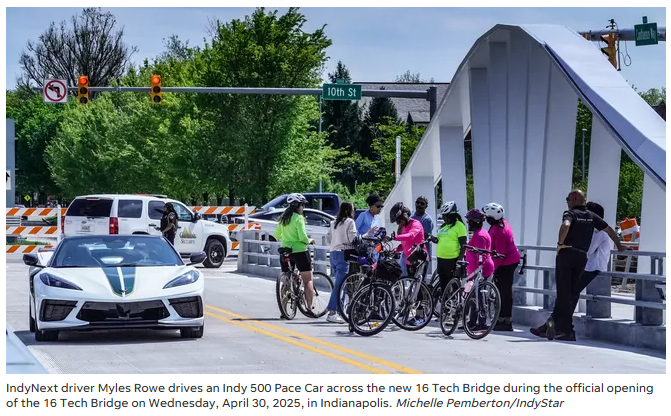Joe Glass, Executive Director & General Counsel
The Indianapolis Local Public Improvement Bond Bank
The Indianapolis Local Public Improvement Bond Bank
Add this issuer to your watchlist to get alerts about important updates.
A new $30 million bridge that links the 16 Tech Innovation District with the hospitals along 10th Street and the Indiana University School of Medicine is the first bridge in Indianapolis to devote more space to pedestrians and bicyclists than to vehicles.

Spanning Fall Creek near where it meets the White River, the 342-foot-long "16 Tech Bridge" features two lanes of car traffic surrounded on either side by protected multi-use paths. The wave-like steel and concrete structure connects two burgeoning economic centers and creates a seamless nexus between the White River Trail and the Indianapolis Cultural Trail for cyclists and pedestrians, the architects say.
Initial plans called for the bridge to have four lanes for vehicles and less space for other users, Indianapolis City-County Council President Vop Osili said at an April 30 grand opening. But residents in near northwest side neighborhoods like Riverside and Ransom Place, including members of the cycling club Riverside Riders Indy, convinced city leaders and architects to change course on the final design for the bridge.
"Even more than being a reflection of the water and the trees of which it is a part," Osili said to a crowd gathered for the opening, "it is a reflection of collaboration, a reflection of possibility and proof of what can happen when we build with the community and not around it."

The new structure blends the functions of two nearby bridges that also link downtown Indianapolis with the somewhat isolated 16 Tech district, home to the AMP food hall and three facilities that house more than 1,000 employees in the health and life sciences industry. Less than a half-mile east, the Indiana Avenue bridge features wide lanes for cars and narrow sidewalks. Fewer than 200 yards west, the Dr. Beurt SerVaas Bridge provides a skinny path for cyclists and walkers.
Each bridge's shortcomings called for a compromise, Riverside Riders founder Adele Hill-Stokes said. The resulting structure, designed by German engineering firm schlaich bergermann partner and New York-based firm Practice for Architecture and Urbanism, finished about a year later than projected in 2021.
"Now we can ride from Riverside Park down the (Riverside Promenade), pick up White River Trail, and then come across the 16 Tech Bridge over to the Cultural Trail and never see street," said Hill-Stokes, who grew up in Riverside in the 1960s and has owned a home there the past two decades. "And that is a great feeling. The cars are just starting to get used to more bikers, but it's still a little hesitant."
The new bridge's spacious multi-use paths feature benches made with wood from trees felled for the project and color-changing light displays for community events. The road over the bridge is called Confluence Way.

Indianapolis taxpayers and the Lilly Endowment footed the roughly $30 million bill to design and build the 16 Tech Bridge, according to 16 Tech officials.
By comparison, the Henry Street bridge extending the Indianapolis Cultural Trail to the new Elanco Animal Health headquarters is expected to cost about $21.2 million. That bridge is projected to open in early 2026.
More than $90 million of taxpayer money has gone toward public infrastructure projects in the 16 Tech District, overseen by the nonprofit 16 Tech Community Corp., since its 2020 opening, officials say.
Indianapolis Mayor Joe Hogsett said during the grand opening that the bridge is a necessary link between downtown hubs of the state's "most vital industries," including biomedical sciences and advanced manufacturing, and growing neighborhoods near the urban core.
The district boasts $300 million of "vertical development" to date and 235 companies. The Vanguard, a 289-unit apartment complex, will open this summer as the district's first residential project, with 15 units reserved for residents earning no more than 30% of the area median income.
Hundreds more residential units, new roads and a three-acre park with public art are expected in the coming years.